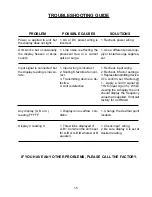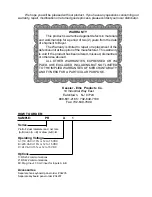
10
CALCULATING THE K FACTORS
Each input (A & B) has a seperate K factor.
The K factor (divider) is the number of pulses
per the desired unit of measure. The K fac-
tor can be any 5 digit number from .0001 to
99999. The K factors for A & B can be
easily calculated by following two simple
steps.
STEP 1 - Calculate a base K factor:
The base K factor is the number of pulse per
the desired unit of measure. Calculate the
base K factor using:
Pulses
= Base K factor
Units value
EXAMPLE #1:
An Encoder with 100 pulses per revolution is
sensing material. 1 Revolution of the shaft
equals 1 foot of material.
Base K factor =
100 (pulses) = 100
1 (foot)
EXAMPLE #2:
An inductive proximity sensor is sensing a
notch on a paper roll (1 pulse per revolu-
tion). Each revolution of the paper roll equals
3 meters of paper.
Base K factor =
1(pulse)
=.3333
3 (meters)
STEP 2 - Calculate the rate K factor:
The rate K factor is the actual number to be
programmed into the unit. Caculate the rate
K factor using:
Rate K factor =
Base K factor
Time conversion factor
TIME CONVERSION FACTORS
Desired rate reading
Factor
Rate Per Second
1
Rate Per Minute
60
Rate Per Hour
3600
EXAMPLE #1:
Using the base K factor from example #1
above, the desired rate reading is Feet Per
Hour.
Rate K factor = 100 (base K factor) = .0277
3600 (time factor)
EXAMPLE #2:
Using the base K factor from example #2
above, the desired rate reading is Meters
Per Minute.
Rate K factor = .3333 (base K )
= .0055
60 (time factor)
The Rate K factor is the number to enter in
the factor section of the program menu (see
Programming Step 1).
TIME CONVERSION CHART
To Convert:
Divide By:
Sec. to Min.
60.00
Sec. to Hrs.
3600
Min. to Sec.
.01667
Min. to Hrs.
60.00
Hrs. to Min.
.01667
Hrs. to Sec.
.00028




































